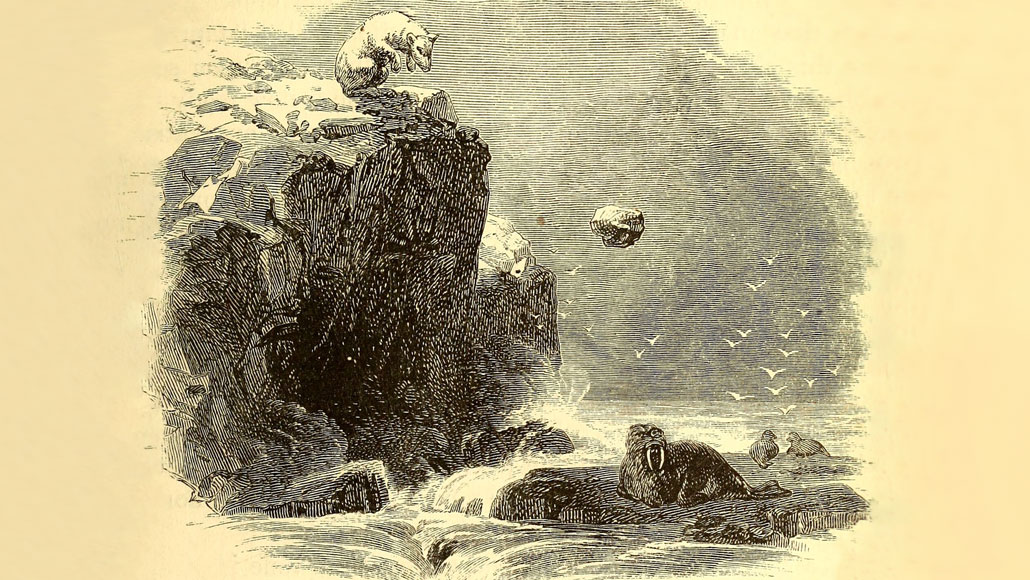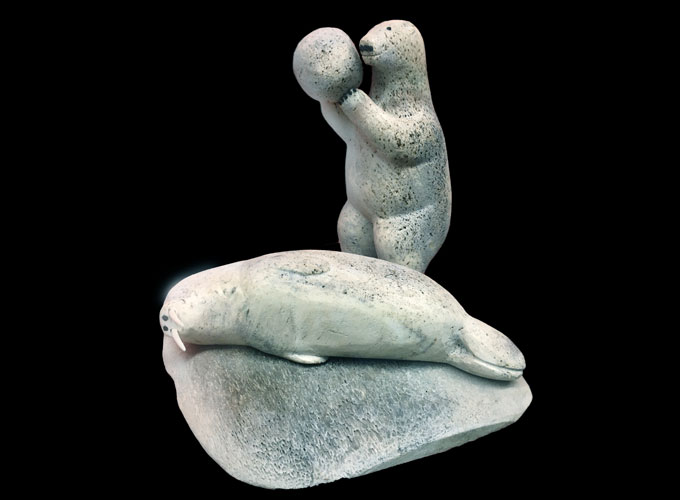
In this illustration, which appears in an 1865 book by adventurer Charles Francis Hall, a polar bear uses a rock as a tool to kill a walrus. Some have thought that Inuit reports of this behavior were just stories, but new research suggests not.
Charles Francis Hall, Library of Congress
- More than 2 years ago
Walruses, weighing as much as 1,300 kilograms with huge tusks and nearly impenetrable skulls, are almost impossible for a hungry polar bear to kill. But new research suggests that some polar bears have invented a work-around — bashing walruses on the head with a block of stone or ice.
For more than 200 years, Inuit in Greenland and the eastern Canadian Arctic have told stories of polar bears (Ursus maritimus) using such tools to aid in killing walruses. Yet explorers, naturalists and writers often dismissed such accounts, relegating them to myth along with tales about shape-shifting bears.
The persistence of these reports, including one report from an Inuk hunter in the late 1990s, coupled with photos of a male polar bear named GoGo at a Japanese zoo using tools to obtain suspended meat compelled Ian Stirling and colleagues to investigate further.
“It’s been my general observation that if an experienced Inuit hunter tells you that he’s seen something, it’s worth listening to and very likely to be correct,” says Stirling, one of the world’s leading polar bear biologists.
The researchers reviewed historical, secondhand observations of tool use in polar bears reported by Inuit hunters to explorers and naturalists as well as recent observations by Inuit hunters and non-Inuit researchers and documented observations of GoGo and brown bears — polar bears’ closest relatives — using tools in captivity to access food. This review suggests that tool use in wild polar bears, though infrequent, does occur in the case of hunting walruses because of their large size, the researchers report in the June Arctic.
“Really, the only species you would want to bonk on the head with a piece of ice would be a walrus,” says Andrew Derocher, director of the Polar Bear Science Lab at the University of Alberta in Edmonton, Canada, who wasn’t involved with the new study. He suspects that it might just be a few polar bears that do this behavior. For example, if a mother bear figured out how to use ice or stone in this way, “it’s something her offspring would pick up on,” but not necessarily a skill polar bears across the Arctic would acquire, he says.
Among animals, using tools to solve problems has long been regarded as a marker of a higher level of what humans consider intelligence. Notoriously smart chimpanzees, for example, craft spears to hunt smaller mammals (SN: 2/28/07). Dolphins carry marine sponges in their mouths to stir sand and uncover prey (SN: 6/8/05). And elephants have been known to drop logs or large rocks onto electric fences to cut off the power supply.
Studies on the cognitive abilities of polar bears are lacking. “We don’t know anything experimental or objective at all,” Stirling says. “However, we have a great deal of observational information that tends to suggest polar bears are really smart.”
Members of the bear family, Ursidae, are typically assumed to have strong cognitive skills as a result of their large brains and evidenced by their sophisticated hunting strategies. Studies on captive American black bears have even revealed some mental capabilities that appear to exceed those of primates.

Gabriel Nirlungayuk, an Inuk hunter of Rankin Inlet in Nunavut, Canada, says he has heard such stories of polar bears using tools to hunt walruses. “I’ve seen polar bears since I was probably 7 years old. I’ve been around them, I’ve hunted alongside them, and I have seen their behaviors. The smartest hunters are usually the female bears.” Sometimes, he says, polar bears will trick young seals to come closer by pretending to be asleep in open water. Other times he’s observed that a polar bear can sniff out a seal’s breathing hole in ice, even if it’s obscured by snow.
“I have worked with the Inuit on traditional knowledge for a very long time and one of my favorite subjects is polar bears, because science often suggests one thing and the Inuit say another thing,” he notes.
There are around 26,000 wild polar bears living in 19 subpopulations across the Arctic and sub-Arctic. The bears primarily eat seals, hunting the marine mammals by staking out above their breathing holes. Because of climate change, Arctic sea ice is fast disappearing, and scientists predict that many polar bear populations will be extinct by the century’s end. Desperate polar bears may increasingly attack walruses, but “there are limitations to how many walruses an adult bear can take down,” says coauthor Kristin Laidre, an Arctic ecologist at the University of Washington in Seattle. It takes a lot of energy.
Following publication of the new study, Stirling received a video from U.S. Geological Survey scientist Anthony Pagano, based in Anchorage, Alaska, who had previously attached a GoPro camera to a wild polar bear for a separate project. That footage, Stirling says, shows a female polar bear sliding a large block of ice around before throwing it into the water at a seal.






